Blockchain for Securing AI Applications and Open Innovations
Abstract
:1. Introduction
Present Study
- To conduct a Bibliometric study for the integration of Blockchain and artificial intelligence considering various application areas.
- To identify various key features of Blockchain that will secure artificial intelligence models.
- To survey various applications of Blockchain for artificial intelligence.
- To understand how Blockchain will provide reliable and private decentralized data storage for training datasets and integrity of AI models and their predictions/results.
2. Research Strategy-Sources and Methods
2.1. Search Strategy
- Query in Scopus is:
- Query in Web of Science is:
2.2. Data Analysis Procedures
3. Quantitative Survey
3.1. Research Trends
3.1.1. Analysis of Documents by Year
3.1.2. Citation Based Analysis
3.2. Research Virtu
3.2.1. Language Trends of Publication
3.2.2. Top 10 Keywords from Scopus Database
3.2.3. Analysis by Document Type
3.2.4. Analysis by Geographical Area
3.2.5. Analysis of Publications Based on the Source
3.3. Potential Research Relationship
Co-Occurrence Analysis (Author Keywords)
3.4. Scholarly and Scientific Literature
3.4.1. Citation Analysis of Documents
3.4.2. Citation Analysis of Sources
3.4.3. Citation Analysis of Authors
3.4.4. Bibliographic Coupling of Documents
3.4.5. Network Map of Publication Title and Citation
4. Qualitative Survey
4.1. Background
4.2. Taxonomy of Literature Selected for Review
4.2.1. Application Areas—The Amalgamation of Blockchain and AI
- Recommender System
- IoV Based Smart City Deployment
- Energy Market
- AI-Based Healthcare Application
- Mobile Edge Network
4.2.2. Discussion on Amalgamation of Blockchain and AI
4.3. Blockchain as a Solution to Detect and Mitigate Different Attacks
- When the intruder impersonates many people at once, this is known as Sybil’s attack. As a result, when connecting to a P2P network, this becomes a big issue. To participate in the mining process, each node must solve a complex cryptographic puzzle. It is still possible to increase ownership but having the computing resources to solve the puzzle is difficult. With the addition of leading zeros, the Cryptographic problem becomes more complicated. Therefore, PoW is a balanced way to combat Sybil’s attacks during mining [77].
- A Blockchained access control framework can significantly reduce the data poisoning attack in the IoE environment. Data can be securely communicated within fog servers and IoT smart devices [78].
- A secure distributed model can be facilitated for Cyber threat intelligence sharing among diverse participants using Blockchain technology. It will ensure tamper-proof electronic records and immutable execution by smart contracts [79].
- Rogue devices can be prevented from gaining access to the server by integrating IoT with Ethereum. Static resource allocation for the devices can address DDoS attacks [80].
- Malware injection attacks (e.g., Ransomware attacks) are network attacks triggered by encrypting sensitive victim files, resulting in abnormal behavior on its system or unexpected program closure. To save files or activate the application, you need a configuration key to be obtained by paying to use it. With a distributed blockchain ledger and its tamper-proof feature, a consortium Blockchain was introduced on the IoT network to address this security issue [81].
5. Discussion
- Most of the literature is available in the English language from Scopus and the Web of Science core collection.
- The year 2020 acknowledged the progressive rise in the research of Blockchain and AI together.
- Conference papers and articles are in big number as compared to other review articles considering both databases.
- China and the USA are the leading countries in the research contribution. Also, India has a good number of publications.
- The most preferred source for publishing the research work is Lecture Notes in Computer Science including subseries Lecture Notes in Artificial Intelligence and Lecture Notes in Bioinformatics.
- “Ouroboros: A provably secure proof-of-stake blockchain protocol,” an article retrieved from the Scopus database, has gained more citations. From Web of Science core collection “Blockchain for AI: Review and Open Research Challenges” cited by most researchers.
- “Blockchain” and “Artificial Intelligence” have the highest keyword co-occurrence link strength.
- “Salah K.” has contributed a lot to the research of Blockchain and Artificial Intelligence.
5.1. Limitations in Integrating Blockchain with Artificial Intelligence
5.1.1. Technical
- Scalability:
- Interoperability:
- Privacy:
- Energy Consumption:
- Blockchain Security:
5.1.2. Legal
- Smart Contract:
5.1.3. Regulatory
- Governance:
5.1.4. Ethical
- Over-hype Technical Potential:
5.2. Open Innovation, Artificial Intelligence and Blockchain
5.3. Future Directions in Blockchain for Artificial Intelligence
6. Conclusions
Author Contributions
Funding
Institutional Review Board Statement
Informed Consent Statement
Data Availability Statement
Conflicts of Interest
References
- Casino, F.; Dasaklis, T.K.; Patsakis, C. A Systematic Literature Review of Blockchain-Based Applications: Current Status, Classification and Open Issues. Telemat. Inform. 2019, 36, 55–81. [Google Scholar] [CrossRef]
- di Francesco Maesa, D.; Mori, P. Blockchain 3.0 Applications Survey. J. Parallel Distrib. Comput. 2020, 138, 99–114. [Google Scholar] [CrossRef]
- Mcbee, M.P.; Wilcox, C. Blockchain Technology: Principles and Applications in Medical Imaging. J. Digit. Imaging 2020, 33, 726–734. [Google Scholar] [CrossRef] [PubMed]
- Park, H.S. Technology Convergence, Open Innovation, and Dynamic Economy. J. Open Innov. Technol. Mark. Complex. 2017, 3, 24. [Google Scholar] [CrossRef] [Green Version]
- Yun, J.J.; Zhao, X.; Jung, K.; Yigitcanlar, T. The Culture for Open Innovation Dynamics. Sustainability 2020, 12, 5076. [Google Scholar] [CrossRef]
- Cockburn, I.; Henderson, R.; Stern, S. The Impact of Artificial Intelligence on Innovation; National Bureau of Economic Research: Cambridge, MA, USA, 2018. [Google Scholar] [CrossRef]
- João, M.; Correia, M. The Impact of Artificial Intelligence on Innovation Management-A Case Study of Aveiro Region. Ph.D. Thesis, ISCTE Business School, Lisboa, Portugal, 2020. [Google Scholar]
- Schenk, E.; Schaeffer, V.; Pénin, J. Blockchain and the Future of Open Innovation Intermediaries: The Case of Crowdsourcing Platforms. In Managing Digital Open Innovation; World Scientific Publishing Co.: Singapore, 2020. [Google Scholar] [CrossRef]
- Narayan, R.; Tidström, A. Blockchains for Accelerating Open Innovation Systems for Sustainability Transitions. In Blockchain Economics: Implications of Distributed Ledgers: Markets, Communications Networks, and Algorithmic Reality; World Scientific Publishing Company: Singapore, 2019. [Google Scholar] [CrossRef]
- Lluis De La Rosa, J.; Torres-Padrosa, V.; El-Fakdi, A.; Gibovic, D.; Hornyák, O.; Maicher, L.; Miralles, F. A Survey of Blockchain Technologies for Open Innovation. Available online: http://eia.udg.edu/~aelfakdi/papers/woic17.pdf (accessed on 13 August 2021).
- Comiter, M. Attacking Artificial Intelligence AI’s Security Vulnerability and What Policymakers Can Do about It. 2019. Available online: https://www.belfercenter.org/publication/AttackingAI (accessed on 13 August 2021).
- Mothukuri, V.; Parizi, R.M.; Pouriyeh, S.; Huang, Y.; Dehghantanha, A.; Srivastava, G. A Survey on Security and Privacy of Federated Learning. Future Gener. Comput. Syst. 2021, 115, 619–640. [Google Scholar] [CrossRef]
- Short, A.R.; Leligou, H.C.; Papoutsidakis, M.; Theocharis, E. Using Blockchain Technologies to Improve Security in Federated Learning Systems. In Proceedings of the 2020 IEEE 44th Annual Computers, Software, and Applications Conference, COMPSAC 2020, Madrid, Spain, 13–17 July 2020; Institute of Electrical and Electronics Engineers Inc.: Manhattan, NY, USA, 2020; pp. 1183–1188. [Google Scholar] [CrossRef]
- Yang, Q.; Liu, Y.; Cheng, Y.; Kang, Y.; Chen, T.; Yu, H. Federated Learning. Synth. Lect. Artif. Intell. Mach. Learn. 2020, 13. [Google Scholar] [CrossRef]
- Ebrahim, N.A. How to Write a Bibliometric Paper. Res. Visibility Impact 2017. Available online: https://figshare.com/articles/presentation/How_to_Write_a_Bibliometric_Paper/5374615/1 (accessed on 13 August 2021). [CrossRef]
- Van Eck, N.J.; Waltman, L. Software Survey: VOSviewer, a Computer Program for Bibliometric Mapping. Scientometrics 2010, 84, 523–538. [Google Scholar] [CrossRef] [Green Version]
- Bokhare, A.; Metkewar, P.S. Visualization and Interpretation of Gephi and Tableau: A Comparative Study. In Advances in Electrical and Computer Technologies: Select Proceedings of ICAECT 2020; Springer: Singapore, 2021. [Google Scholar] [CrossRef]
- Yaga, D.; Mell, P.; Roby, N.; Scarfone, K. Blockchain Technology Overview. In NIST Interagency/Internal Report (NISTIR); National Institute of Standards and Technology: Gaithersburg, MD, USA, 2019. [Google Scholar] [CrossRef]
- Xu, M.; Chen, X.; Kou, G. A Systematic Review of Blockchain. Financ. Innov. 2019, 5, 27. [Google Scholar] [CrossRef] [Green Version]
- Zhang, R.; Xue, R.; Liu, L. Security and Privacy on Blockchain. ACM Comput. Surv. 2019, 52, 1–34. [Google Scholar] [CrossRef] [Green Version]
- Bagga, P.; Sutrala, A.K.; Das, A.K.; Vijayakumar, P. Blockchain-Based Batch Authentication Protocol for Internet of Vehicles. J. Syst. Archit. 2021, 113, 101877. [Google Scholar] [CrossRef]
- Jogunola, O.; Adebisi, B.; Ikpehai, A.; Popoola, S.I.; Gui, G.; Gacanin, H.; Ci, S. Consensus Algorithms and Deep Reinforcement Learning in Energy Market: A Review. IEEE Internet Things J. 2021, 15, 4211–4227. [Google Scholar] [CrossRef]
- Feng, L.; Yang, Z.; Guo, S.; Qiu, X.; Li, W.; Yu, P. Two-Layered Blockchain Architecture for Federated Learning over Mobile Edge Network. IEEE Netw. 2021. [Google Scholar] [CrossRef]
- Baranwal Somy, N.; Kannan, K.; Arya, V.; Hans, S.; Singh, A.; Lohia, P.; Mehta, S. Ownership Preserving AI Market Places Using Blockchain. In Proceedings of the 2019 2nd IEEE International Conference on Blockchain, Blockchain 2019, Atlanta, GA, USA, 14–17 July 2019; pp. 156–165. [Google Scholar] [CrossRef] [Green Version]
- Malhotra, D.; Srivastava, S.; Saini, P.; Singh, A.K. Blockchain Based Audit Trailing of XAI Decisions: Storing on IPFS and Ethereum Blockchain. In Proceedings of the 2021 International Conference on COMmunication Systems and NETworkS, COMSNETS 2021, Bangalore, India, 5–9 January 2021. [Google Scholar] [CrossRef]
- Nassar, M.; Salah, K.; ur Rehman, M.H.; Svetinovic, D. Blockchain for Explainable and Trustworthy Artificial Intelligence. Wiley Interdiscip. Rev. Data Min. Knowl. Discov. 2020, 10, e1340. [Google Scholar] [CrossRef]
- Aich, S.; Sinai, N.K.; Kumar, S.; Ali, M.; Choi, Y.R.; Joo, M.I.; Kim, H.C. Protecting Personal Healthcare Record Using Blockchain Federated Learning Technologies. In Proceedings of the International Conference on Advanced Communication Technology, ICACT, Pyeongchang, Korea, 7–10 February 2021; pp. 109–112. [Google Scholar] [CrossRef]
- Muhammad, G.; Hossain, M.S. A Deep-Learning-Based Edge-Centric COVID-19-Like Pandemic Screening and Diagnosis System within a B5G Framework Using Blockchain. IEEE Netw. 2021, 35, 74–81. [Google Scholar] [CrossRef]
- Lisi, A.; de Salve, A.; Mori, P.; Ricci, L. A Smart Contract Based Recommender System. In International Conference on the Economics of Grids, Clouds, Systems, and Services; Springer: Cham, Switzerland, 2019. [Google Scholar] [CrossRef]
- Yeh, T.-Y.; Kashef, R. Trust-Based Collaborative Filtering Recommendation Systems on the Blockchain. Adv. Internet Things 2020, 10, 37–56. [Google Scholar] [CrossRef]
- Lisi, A.; de Salve, A.; Mori, P.; Ricci, L.; Fabrizi, S. Rewarding Reviews with Tokens: An Ethereum-Based Approach. Future Gener. Comput. Syst. 2021, 120, 36–54. [Google Scholar] [CrossRef]
- Lisi, A.; de Salve, A.; Mori, P.; Ricci, L. Practical Application and Evaluation of Atomic Swaps for Blockchain-Based Recommender Systems. In ACM International Conference Proceeding Series; Association for Computing Machinery: New York, NY, USA, 2020; pp. 67–74. [Google Scholar] [CrossRef]
- Wang, S.; Huang, C.; Li, J.; Yuan, Y.; Wang, F.Y. Decentralized Construction of Knowledge Graphs for Deep Recommender Systems Based on Blockchain-Powered Smart Contracts. IEEE Access 2019, 7, 136951–136961. [Google Scholar] [CrossRef]
- Casino, F.; Patsakis, C. An Efficient Blockchain-Based Privacy-Preserving Collaborative Filtering Architecture. IEEE Trans. Eng. Manag. 2020, 67, 1501–1513. [Google Scholar] [CrossRef]
- Zhao, T.; Sun, G.; Feng, X.; Wang, L. Design of Educational Resources-Oriented Fair Recommendation System Based on Consortium Blockchain. In Proceedings of the 2020 International Conference on Networking and Network Applications, NaNA 2020, Haikou, China, 10–13 December 2020; pp. 448–453. [Google Scholar] [CrossRef]
- Wang, J.; Wu, Q. Research on the Blockchain-Based Privacy Protection for Internet Financial Product Recommendation Systems. In Proceedings of the 2020 International Conference on Computer Science and Management Technology, ICCSMT 2020, Shanghai, China, 20–22 November 2020; Institute of Electrical and Electronics Engineers Inc.: New York, NY, USA, 2020; pp. 310–313. [Google Scholar] [CrossRef]
- Omar, A.A.; Bosri, R.; Rahman, M.S.; Begum, N.; Bhuiyan, M.Z.A. Towards Privacy-Preserving Recommender System with Blockchains. In Communications in Computer and Information Science; Springer: Singapore, 2019; Volume 1123, pp. 106–118. [Google Scholar] [CrossRef]
- Lu, Y.; Huang, X.; Zhang, K.; Maharjan, S.; Zhang, Y. Blockchain Empowered Asynchronous Federated Learning for Secure Data Sharing in Internet of Vehicles. IEEE Trans. Veh. Technol. 2020, 69, 4298–4311. [Google Scholar] [CrossRef]
- Peng, Y.; Chen, Z.; Chen, Z.; Ou, W.; Han, W.; Ma, J. BFLP: An Adaptive Federated Learning Framework for Internet of Vehicles. Mob. Inf. Syst. 2021, 2021, 6633332. [Google Scholar] [CrossRef]
- Jiang, X.; Ma, Z.; Richard Yu, F.; Song, T.; Boukerche, A. Edge Computing for Video Analytics in the Internet of Vehicles with Blockchain. In Proceedings of the DIVANet 2020—Proceedings of the 10th ACM Symposium on Design and Analysis of Intelligent Vehicular Networks and Applications, Aliante, Spain, 22–26 November 2021; pp. 1–7. [Google Scholar] [CrossRef]
- Shukla, A.; Bhattacharya, P.; Tanwar, S.; Kumar, N.; Guizani, M. DwaRa: A Deep Learning-Based Dynamic Toll Pricing Scheme for Intelligent Transportation Systems. IEEE Trans. Veh. Technol. 2020, 69, 12510–12520. [Google Scholar] [CrossRef]
- Wang, S.; Sun, S.; Wang, X.; Ning, Z.; Rodrigues, J.J.P.C. Secure Crowdsensing in 5G Internet of Vehicles: When Deep Reinforcement Learning Meets Blockchain. IEEE Consum. Electron. Mag. 2020, 10, 72–81. [Google Scholar] [CrossRef]
- Song, Y.; Fu, Y.; Yu, F.R.; Zhou, L. Blockchain-Enabled Internet of Vehicles with Cooperative Positioning: A Deep Neural Network Approach. IEEE Internet Things J. 2020, 7, 3485–3498. [Google Scholar] [CrossRef]
- Lin, H.; Garg, S.; Hu, J.; Kaddoum, G.; Peng, M.; Shamim Hossain, M. Blockchain and Deep Reinforcement Learning Empowered Spatial Crowdsourcing in Software-Defined Internet of Vehicles. IEEE Trans. Intell. Transp. Syst. 2021, 22, 3755–3764. [Google Scholar] [CrossRef]
- Long, Y.; Chen, Y.; Ren, W.; Dou, H.; Xiong, N.N. DePET: A Decentralized Privacy-Preserving Energy Trading Scheme for Vehicular Energy Network via Blockchain and K—Anonymity. IEEE Access 2020, 8, 192587–192596. [Google Scholar] [CrossRef]
- Wang, L.; Liu, J.; Yuan, R.; Wu, J.; Zhang, D.; Zhang, Y.; Li, M. Adaptive Bidding Strategy for Real-Time Energy Management in Multi-Energy Market Enhanced by Blockchain. Appl. Energy 2020, 279, 115866. [Google Scholar] [CrossRef]
- Patil, S.; Joshi, S. Improved Privacy Preservation of Personal Health Records via Tokenization. Int. J. Pure Appl. Math. 2018, 118, 3035–3045. [Google Scholar]
- Bhattacharya, P.; Tanwar, S.; Bodke, U.; Tyagi, S.; Kumar, N. BinDaaS: Blockchain-Based Deep-Learning as-a-Service in Healthcare 4.0 Applications. IEEE Trans. Netw. Sci. Eng. 2019, 8, 1242–1255. [Google Scholar] [CrossRef]
- Chukwu, E.; Garg, L. A Systematic Review of Blockchain in Healthcare: Frameworks, Prototypes, and Implementations. IEEE Access 2020, 8, 21196–21214. [Google Scholar] [CrossRef]
- Farouk, A.; Alahmadi, A.; Ghose, S.; Mashatan, A. Blockchain Platform for Industrial Healthcare: Vision and Future Opportunities. In Computer Communications; Elsevier B.V.: Amsterdam, The Netherlands, 2020; pp. 223–235. [Google Scholar] [CrossRef]
- Khezr, S.; Moniruzzaman, M.; Yassine, A.; Benlamri, R. Blockchain Technology in Healthcare: A Comprehensive Review and Directions for Future Research. Appl. Sci. 2019, 9, 1736. [Google Scholar] [CrossRef] [Green Version]
- Sookhak, M.; Jabbarpour, M.R.; Safa, N.S.; Yu, F.R. Blockchain and Smart Contract for Access Control in Healthcare: A Survey, Issues and Challenges, and Open Issues. J. Netw. Comput. Appl. 2021, 178, 102950. [Google Scholar] [CrossRef]
- Kuo, T.T.; Kim, H.E.; Ohno-Machado, L. Blockchain Distributed Ledger Technologies for Biomedical and Health Care Applications. J. Am. Med. Inform. Assoc. 2017, 24, 1211–1220. [Google Scholar] [CrossRef] [Green Version]
- Cernian, A.; Tiganoaia, B.; Sacala, I.S.; Pavel, A.; Iftemi, A. PatientDataChain: A Blockchain-Based Approach to Integrate Personal Health Records. Sensors 2020, 20, 6538. [Google Scholar] [CrossRef] [PubMed]
- Pandey, P.; Litoriya, R. Securing E-Health Networks from Counterfeit Medicine Penetration Using Blockchain. Wirel. Pers. Commun. 2020, 117, 7–25. [Google Scholar] [CrossRef]
- Shamim Hossain, M.; Muhammad, G.; Guizani, N. Explainable AI and Mass Surveillance System-Based Healthcare Framework to Combat COVID-I9 like Pandemics. IEEE Netw. 2020, 34, 126–132. [Google Scholar] [CrossRef]
- Zerka, F.; Urovi, V.; Vaidyanathan, A.; Barakat, S.; Leijenaar, R.T.H.; Walsh, S.; Gabrani-Juma, H.; Miraglio, B.; Woodruff, H.C.; Dumontier, M.; et al. Blockchain for Privacy Preserving and Trustworthy Distributed Machine Learning in Multicentric Medical Imaging (C-DistriM). IEEE Access 2020, 8, 183939–183951. [Google Scholar] [CrossRef]
- Gupta, R.; Shukla, A.; Tanwar, S. BATS: A Blockchain and AI-Empowered Drone-Assisted Telesurgery System towards 6G. IEEE Trans. Netw. Sci. Eng. 2020. [Google Scholar] [CrossRef]
- Alqaralleh, B.A.Y.; Vaiyapuri, T.; Parvathy, V.S.; Gupta, D.; Khanna, A.; Shankar, K. Blockchain-Assisted Secure Image Transmission and Diagnosis Model on Internet of Medical Things Environment. Pers. Ubiquitous Comput. 2021. [Google Scholar] [CrossRef]
- Veeramakali, T.; Siva, R.; Sivakumar, B.; Senthil Mahesh, P.C.; Krishnaraj, N. An Intelligent Internet of Things-Based Secure Healthcare Framework Using Blockchain Technology with an Optimal Deep Learning Model. J. Supercomput. 2021. [Google Scholar] [CrossRef]
- Mohammed, A.; Nahom, H.; Tewodros, A.; Habtamu, Y.; Hayelom, G. Deep Reinforcement Learning for Computation Offloading and Resource Allocation in Blockchain-Based Multi-UAV-Enabled Mobile Edge Computing. In Proceedings of the 2020 17th International Computer Conference on Wavelet Active Media Technology and Information Processing (ICCWAMTIP), Chengdu, China, 18–20 December 2020. [Google Scholar] [CrossRef]
- Atlam, H.F.; Azad, M.A.; Alzahrani, A.G.; Wills, G. A Review of Blockchain in Internet of Things and AI. Big Data Cogn. Comput. 2020, 4, 28. [Google Scholar] [CrossRef]
- Bouras, M.A.; Lu, Q.; Dhelim, S.; Ning, H. A Lightweight Blockchain-Based IoT Identity Management Approach. Future Internet 2021, 13, 24. [Google Scholar] [CrossRef]
- Dhelim, S.; Ning, H.; Farha, F.; Chen, L.; Atzori, L.; Daneshmand, M. IoT-Enabled Social Relationships Meet Artificial Social Intelligence. IEEE Internet Things J. 2021. [Google Scholar] [CrossRef]
- Kumar, R.; Wang, W.Y.; Kumar, J.; Yang, T.; Khan, A.; Ali, W.; Ali, I. An Integration of Blockchain and AI for Secure Data Sharing and Detection of CT Images for the Hospitals. Comput. Med. Imaging Graph. 2021, 87, 101812. [Google Scholar] [CrossRef]
- Krittanawong, C.; Rogers, A.J.; Aydar, M.; Choi, E.; Johnson, K.W.; Wang, Z.; Narayan, S.M. Integrating Blockchain Technology with Artificial Intelligence for Cardiovascular Medicine. Nat. Rev. Cardiol. 2020, 17, 259–260. [Google Scholar] [CrossRef] [PubMed]
- Azzaoui, A.E.; Singh, S.K.; Pan, Y.; Park, J.H. Block5GIntell: Blockchain for AI-Enabled 5G Networks. IEEE Access 2020, 8, 145918–145935. [Google Scholar] [CrossRef]
- Kashif, H.; Sarwar, B.I.; Nadeem, S.; Waheed, A.; Zaigham, M.; Tayyaba, R. Integration of 5G and Block-Chain Technologies in Smart Telemedicine Using IoT. J. Healthc. Eng. 2021, 21, 8814364. [Google Scholar] [CrossRef]
- Zhou, S.; Huang, H.; Chen, W.; Zheng, Z.; Guo, S. Pirate: A Blockchain-Based Secure Framework of Distributed Machine Learning in 5G Networks. IEEE Netw. 2020, 34, 84–91. [Google Scholar] [CrossRef]
- Kim, H.; Park, J.; Bennis, M.; Kim, S.L. Blockchained On-Device Federated Learning. IEEE Commun. Lett. 2020, 24, 1279–1283. [Google Scholar] [CrossRef] [Green Version]
- Qu, Y.; Pokhrel, S.R.; Garg, S. A Blockchained Federated Learning Framework for Cognitive Computing in Industry 4.0 Networks. IEEE Trans. Ind. Inform. 2020, 17, 2964–2973. [Google Scholar] [CrossRef]
- Yang, W.; Lim, B.; Luong, N.C.; Hoang, D.T. Federated Learning in Mobile Edge Networks: A Comprehensive Survey. IEEE Commun. Surv. Tutor. 2020, 22, 2031–2063. [Google Scholar] [CrossRef] [Green Version]
- Alrubei, S.; Ball, E.; Rigelsford, J. The Use of Blockchain to Support Distributed AI Implementation in IoT Systems. IEEE Internet Things J. 2021. [Google Scholar] [CrossRef]
- Yamin, M.M.; Ullah, M.; Ullah, H.; Katt, B. Weaponized AI for Cyber Attacks. J. Inf. Secur. Appl. 2021, 57, 102722. [Google Scholar] [CrossRef]
- Ren, K.; Zheng, T.; Qin, Z.; Liu, X. Adversarial Attacks and Defenses in Deep Learning. Engineering 2020, 6, 346–360. [Google Scholar] [CrossRef]
- Kamat, P.; Gite, S.; Patil, S. Mobile Agent Communication, Security Concerns, and Approaches: An Insight into Different Kinds of Vulnerabilities a Mobile Agent Could Be Subjected to and Measures to Control Them. In Research Anthology on Securing Mobile Technologies and Applications; IGI Global: Hershey, PA, USA, 2021; pp. 23–34. [Google Scholar]
- Asfia, U.; Kamuni, V.; Sutavani, S.; Sheikh, A.; Wagh, S.; Singh, N.M. A Blockchain Construct for Energy Trading against Sybil Attacks. In Proceedings of the 2019 27th Mediterranean Conference on Control and Automation (MED), Akko, Israel, 1–4 July 2019. [Google Scholar] [CrossRef]
- Bera, B.; Das, A.K.; Obaidat, M.; Vijayakumar, P.; Hsiao, K.F.; Park, Y. AI-Enabled Blockchain-Based Access Control for Malicious Attacks Detection and Mitigation in IoE. IEEE Consum. Electron. Mag. 2020. [Google Scholar] [CrossRef]
- Hajizadeh, M.; Afraz, N.; Ruffini, M.; Bauschert, T. Collaborative Cyber Attack Defense in SDN Networks Using Blockchain Technology. In Proceedings of the 2020 6th IEEE Conference on Network Softwarization (NetSoft), Ghent, Belgium, 29 June–3 July 2020. [Google Scholar] [CrossRef]
- Javaid, U.; Siang, A.K.; Aman, M.N.; Sikdar, B. Mitigating IoT Device Based DDoS Attacks Using Blockchain. In Proceedings of the CRYBLOCK 2018—Proceedings of the 1st Workshop on Cryptocurrencies and Blockchains for Distributed Systems, Part of MobiSys 2018, Munich, Germany, 15 June 2018; pp. 71–76. [Google Scholar] [CrossRef]
- Lei, I.S.; Tang, S.K.; Tse, R. Integrating Consortium Blockchain into Edge Server to Defense against Ransomware Attack. In Procedia Computer Science; Elsevier B.V.: Amsterdam, The Netherlands, 2020; Volume 177, pp. 120–127. [Google Scholar] [CrossRef]
- Liang, L.; Cao, X.; Zhang, J.; Sun, C. SLC: A Permissioned Blockchain for Secure Distributed Machine Learning against Byzantine Attacks. In Proceedings of the 2020 Chinese Automation Congress (CAC), Shanghai, China, 6–8 November 2020. [Google Scholar] [CrossRef]
- Meng, W.; Li, W.; Yang, L.T.; Li, P. Enhancing Challenge-Based Collaborative Intrusion Detection Networks against Insider Attacks Using Blockchain. Int. J. Inf. Secur. 2020, 19, 279–290. [Google Scholar] [CrossRef]
- Salah, K.; Member, S.; Rehman, M.H.U.R. Blockchain for AI: Review and Open Research Challenges. IEEE Access 2019, 7, 10127–10149. [Google Scholar] [CrossRef]
- Dinh, T.N.; Thai, M.T. AI and Blockchain: A Disruptive Integration. Computer 2018, 51, 48–53. [Google Scholar] [CrossRef]
- Corea, F. The Convergence of AI and Blockchain. In Applied Artificial Intelligence: Where AI Can Be Used in Business; Springer: Cham, Switzerland, 2019. [Google Scholar] [CrossRef]
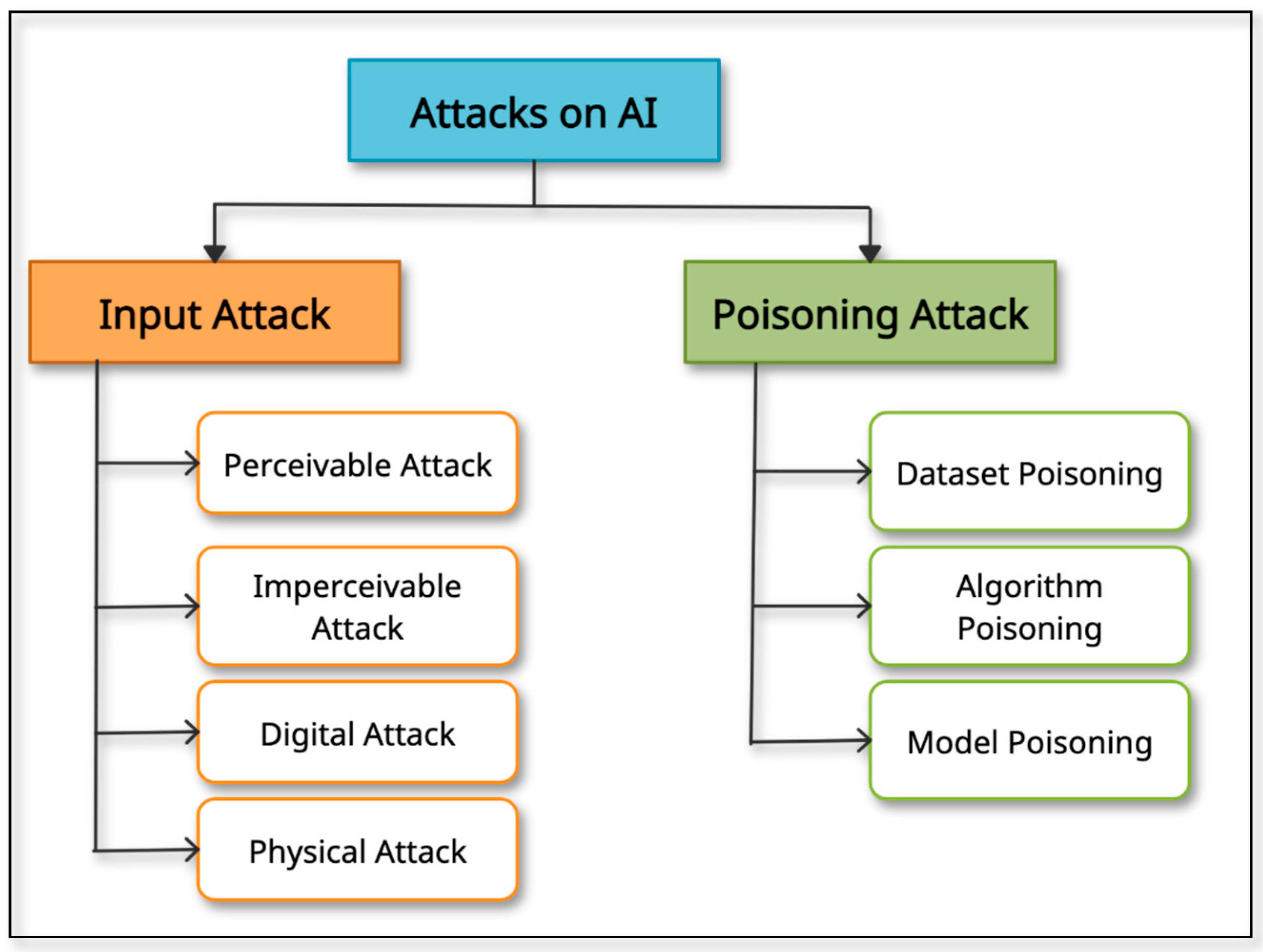
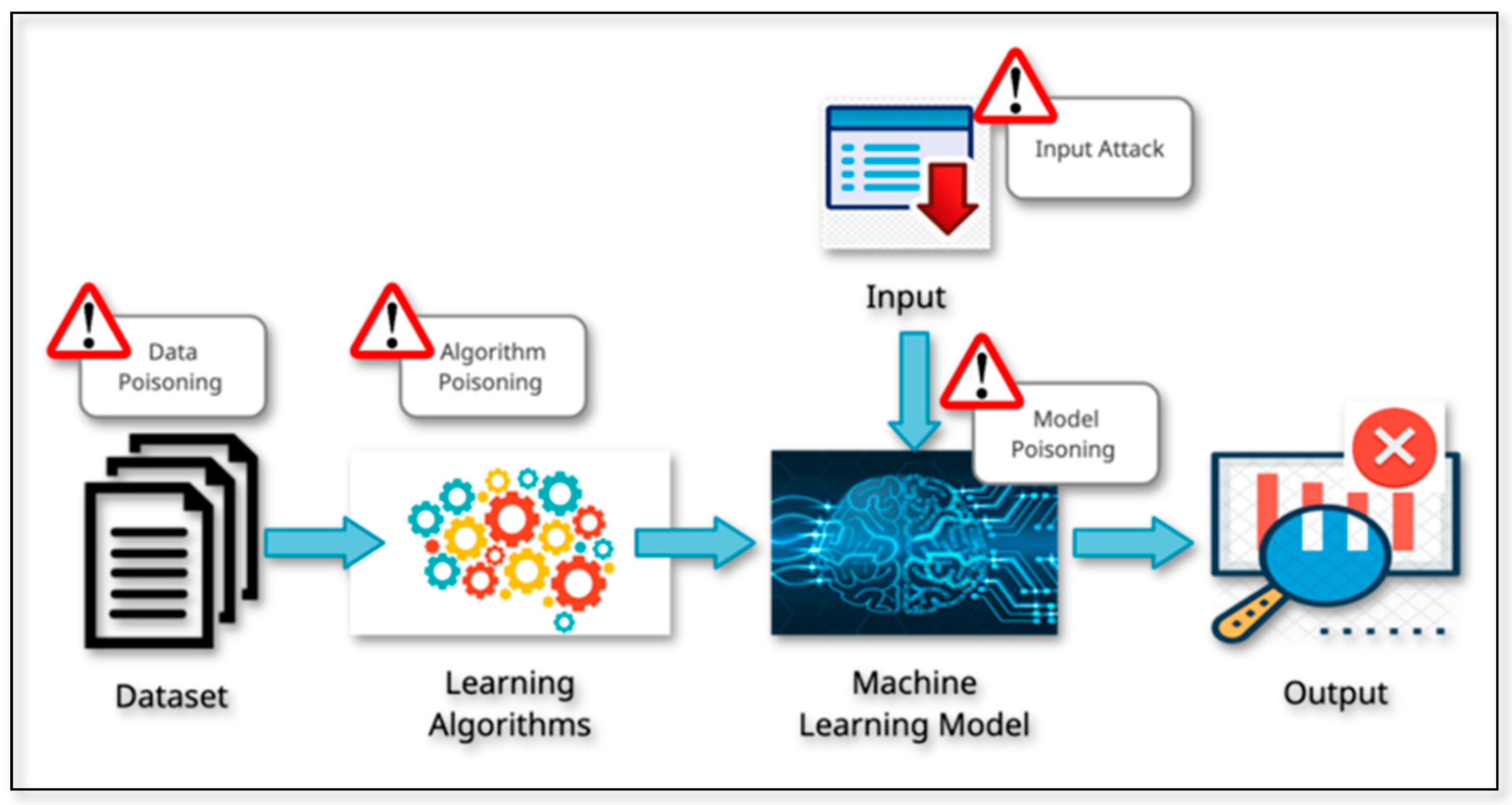
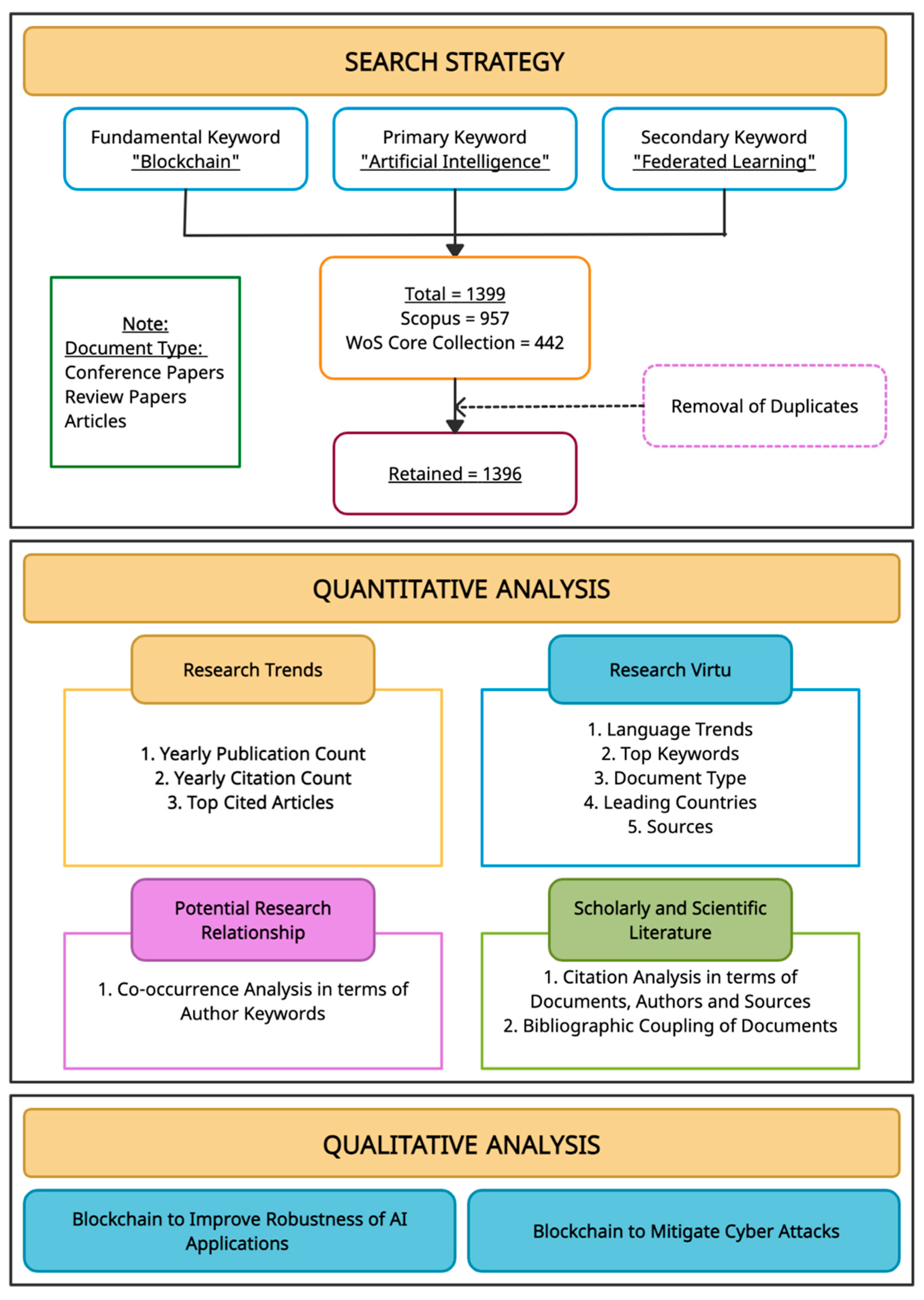
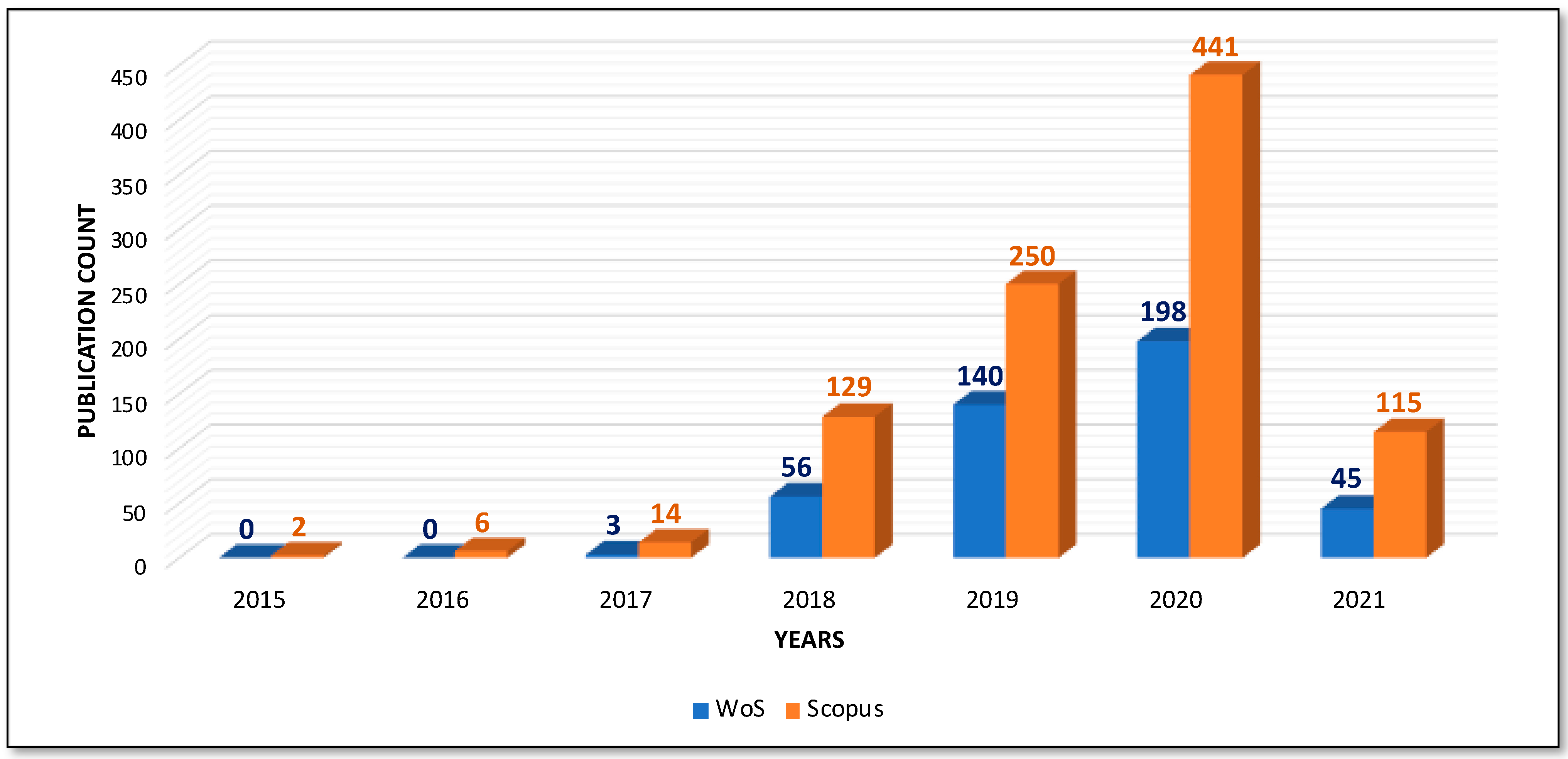
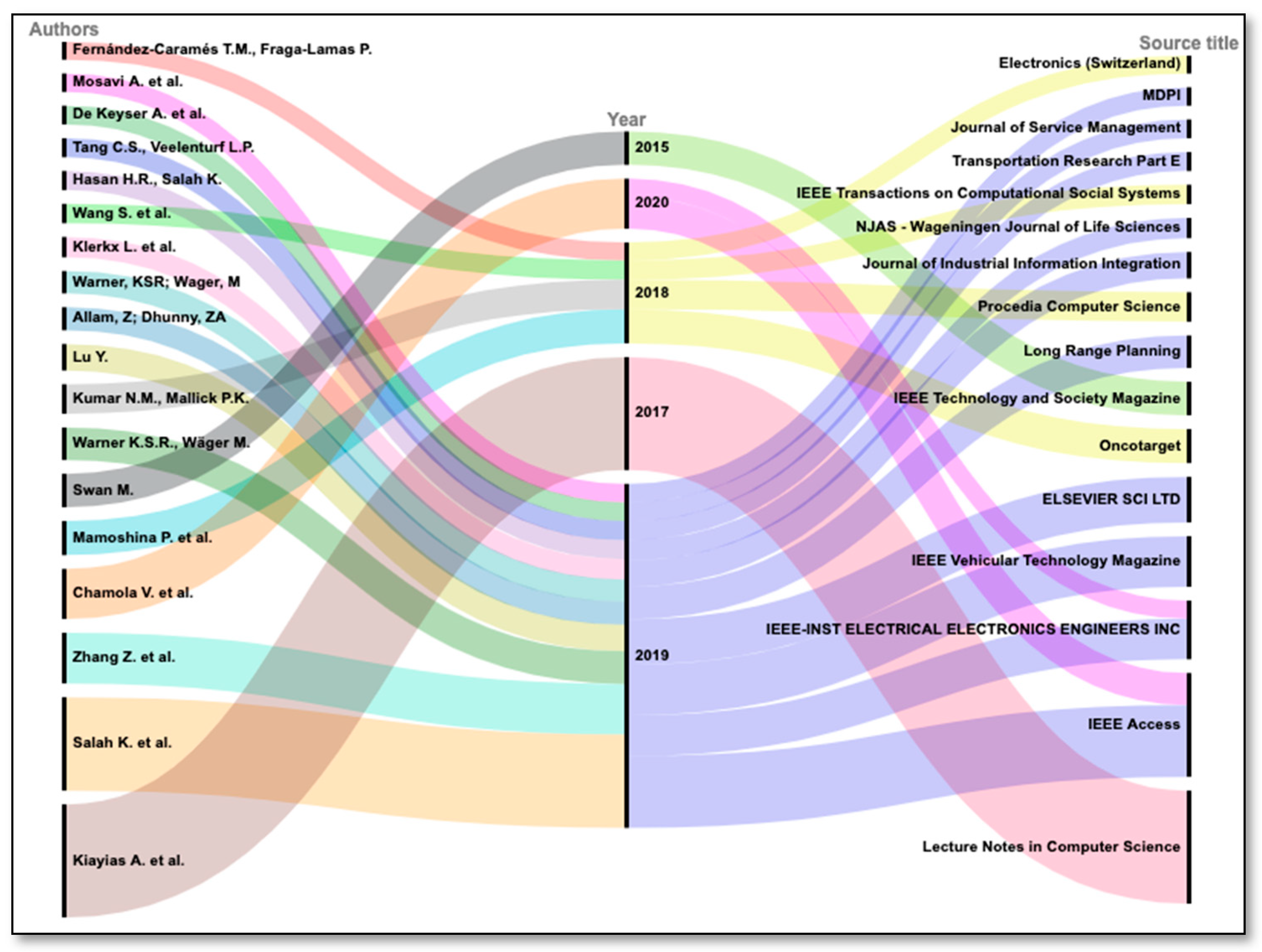


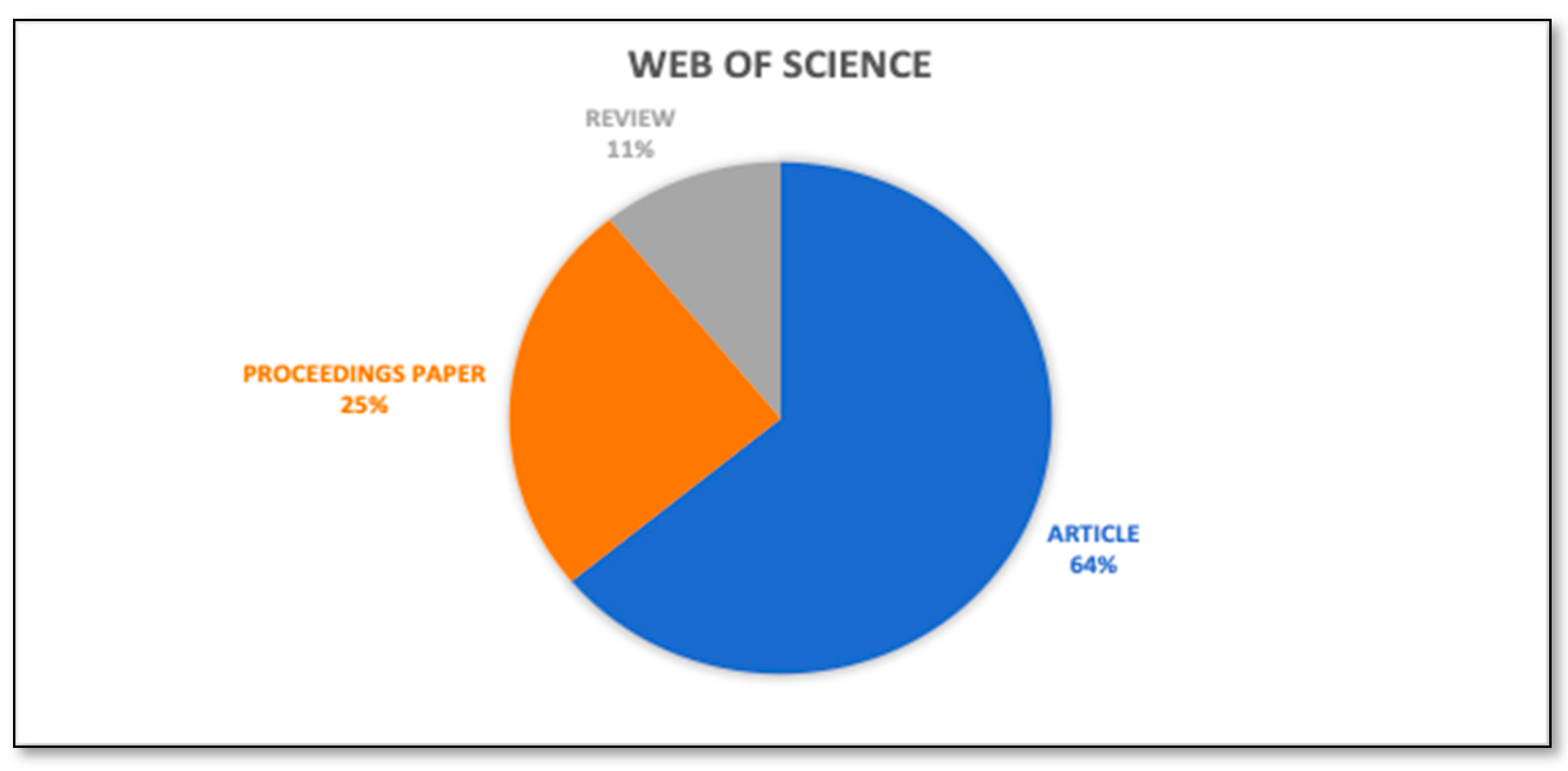
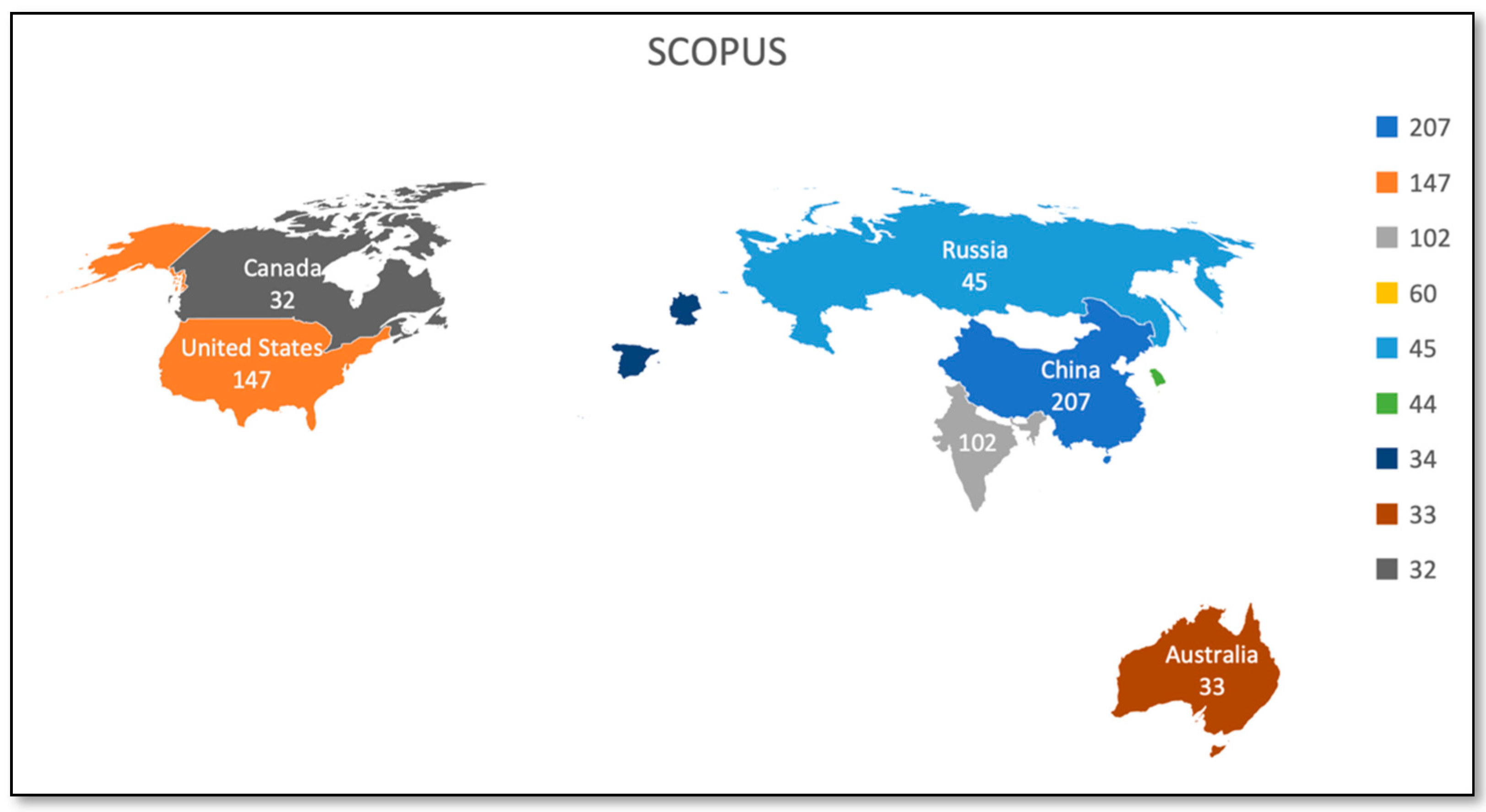
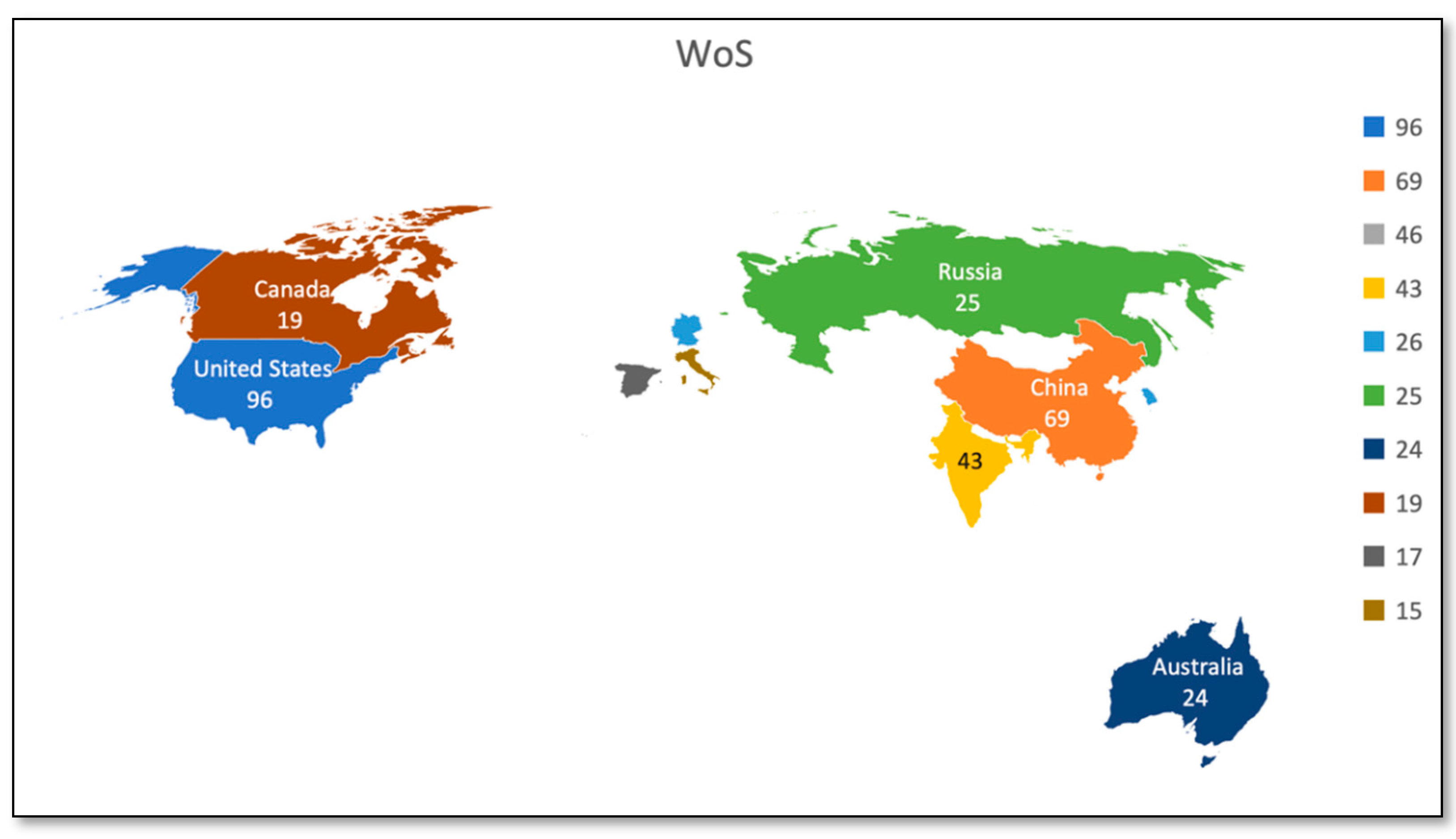


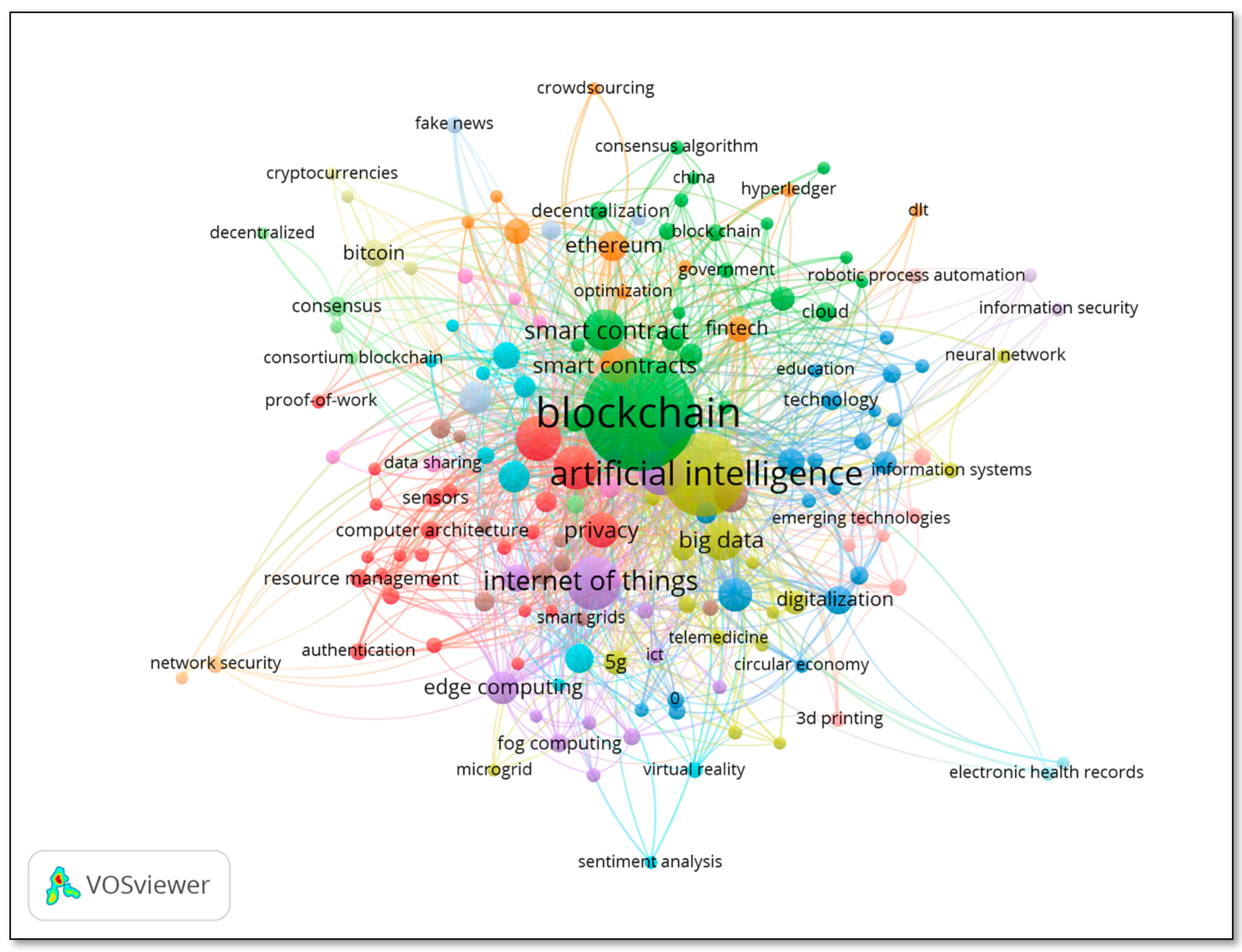
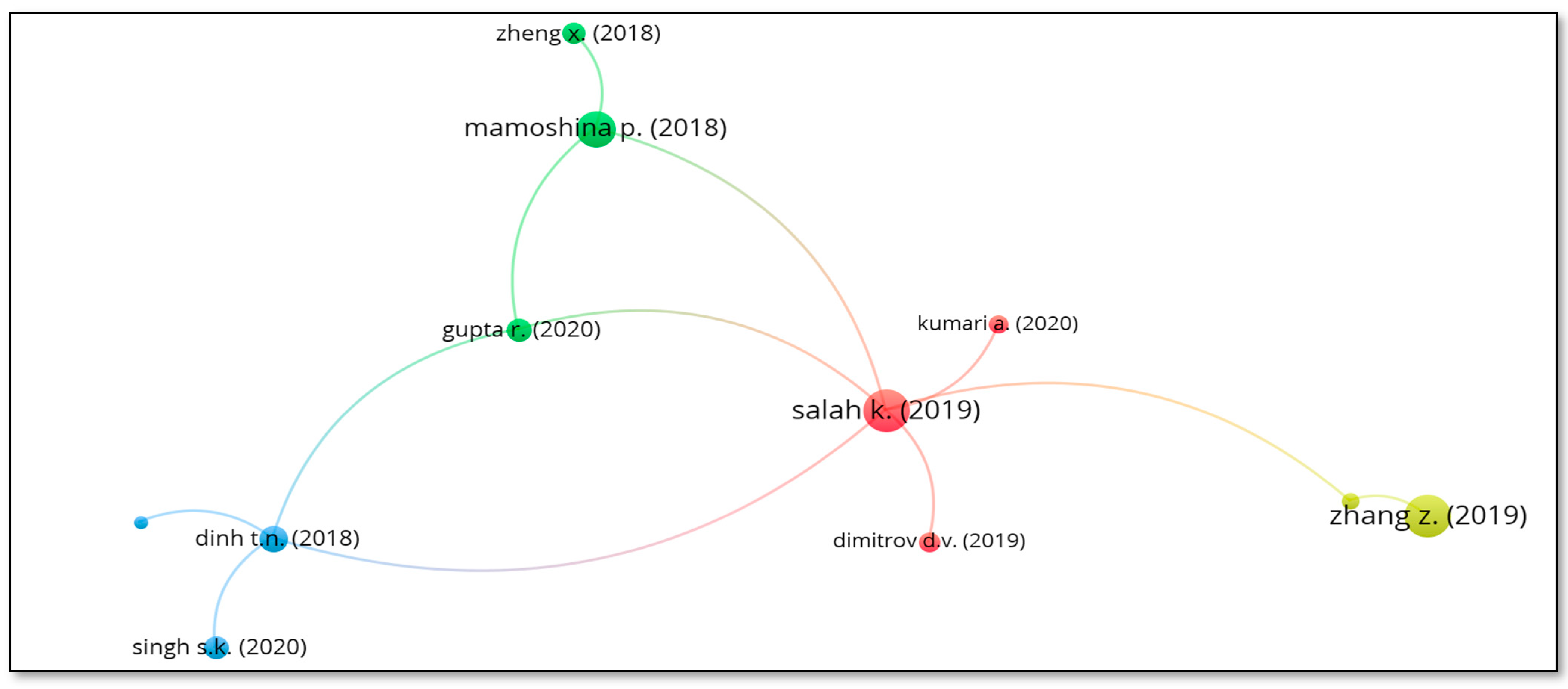


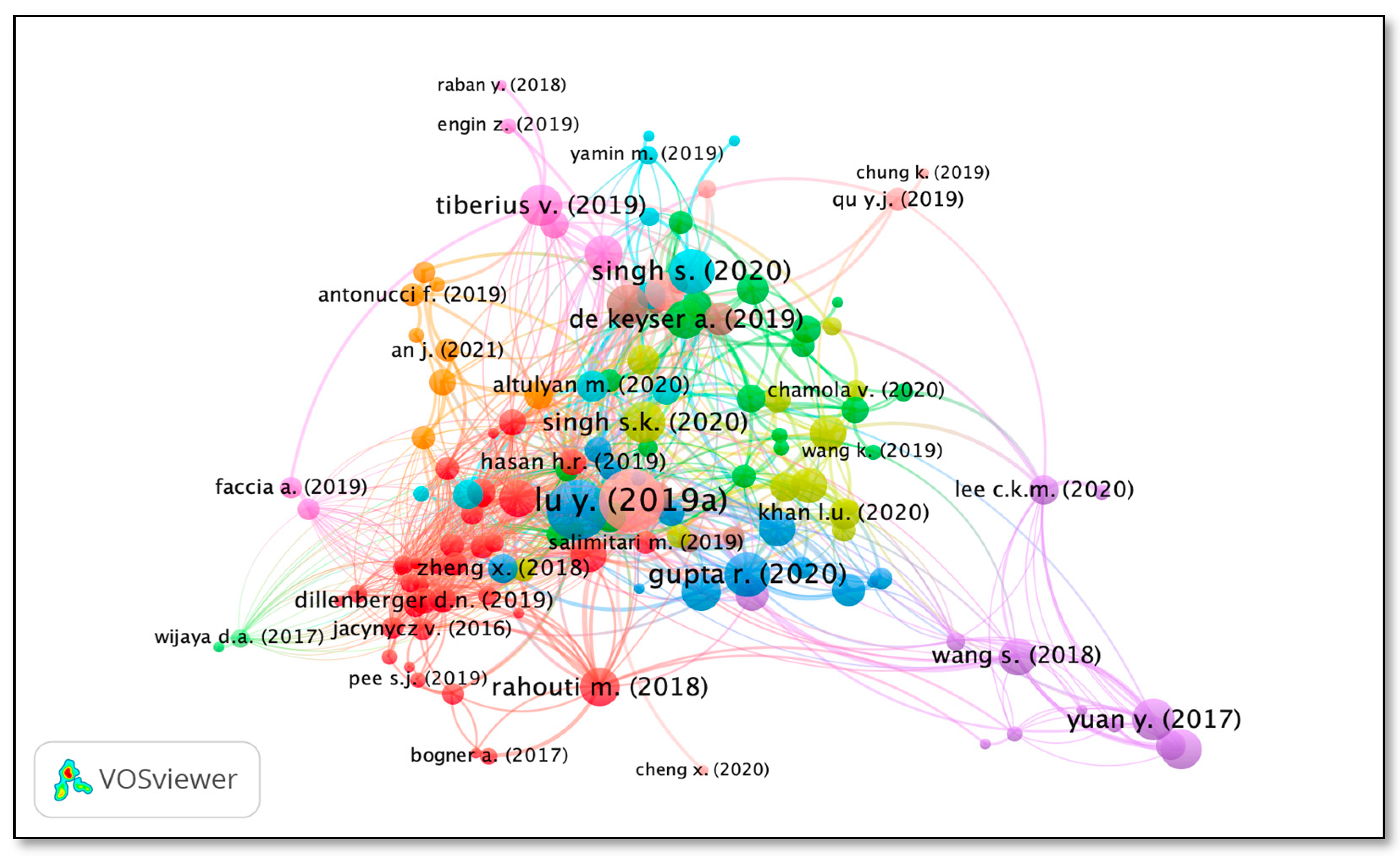

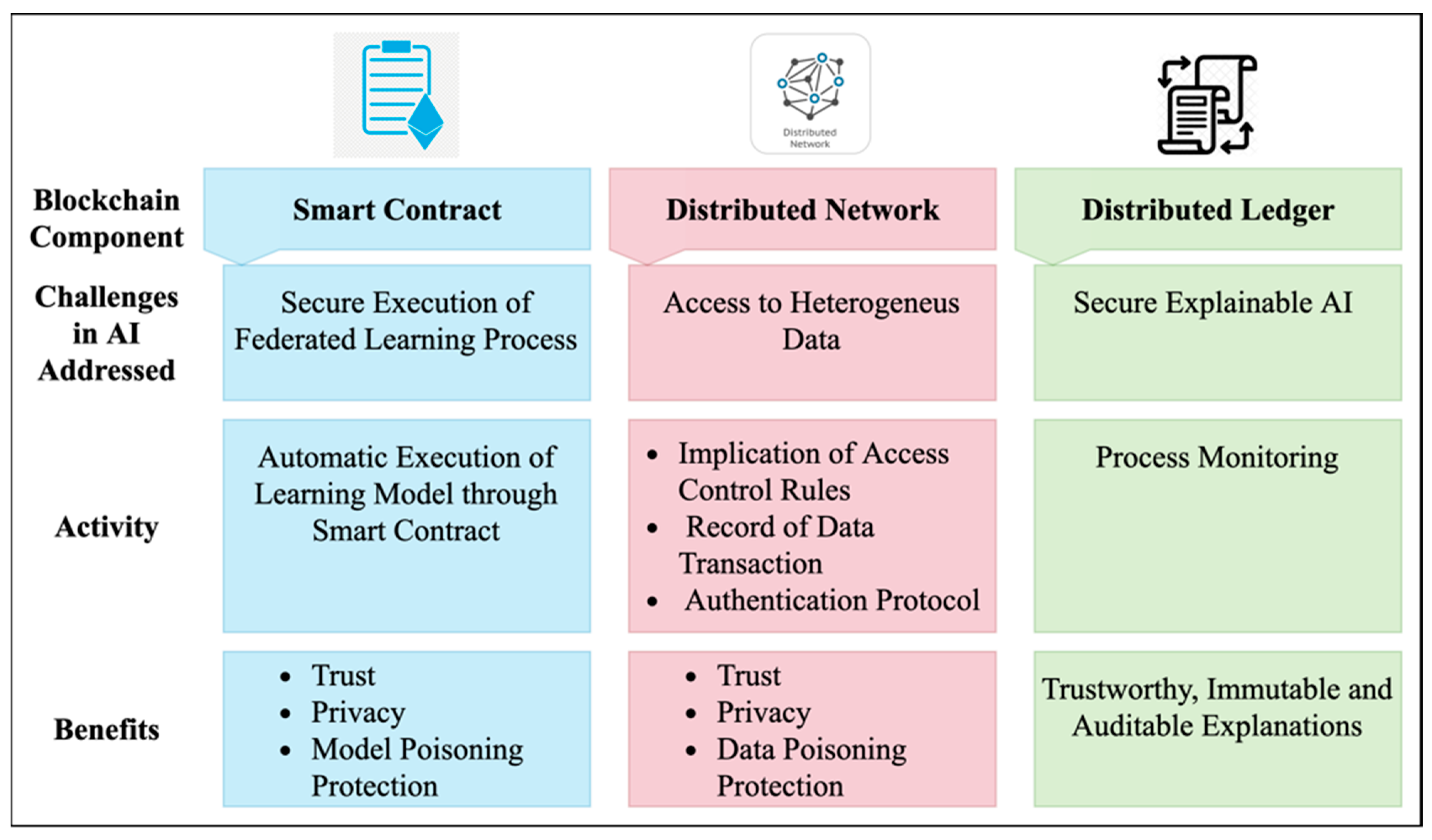
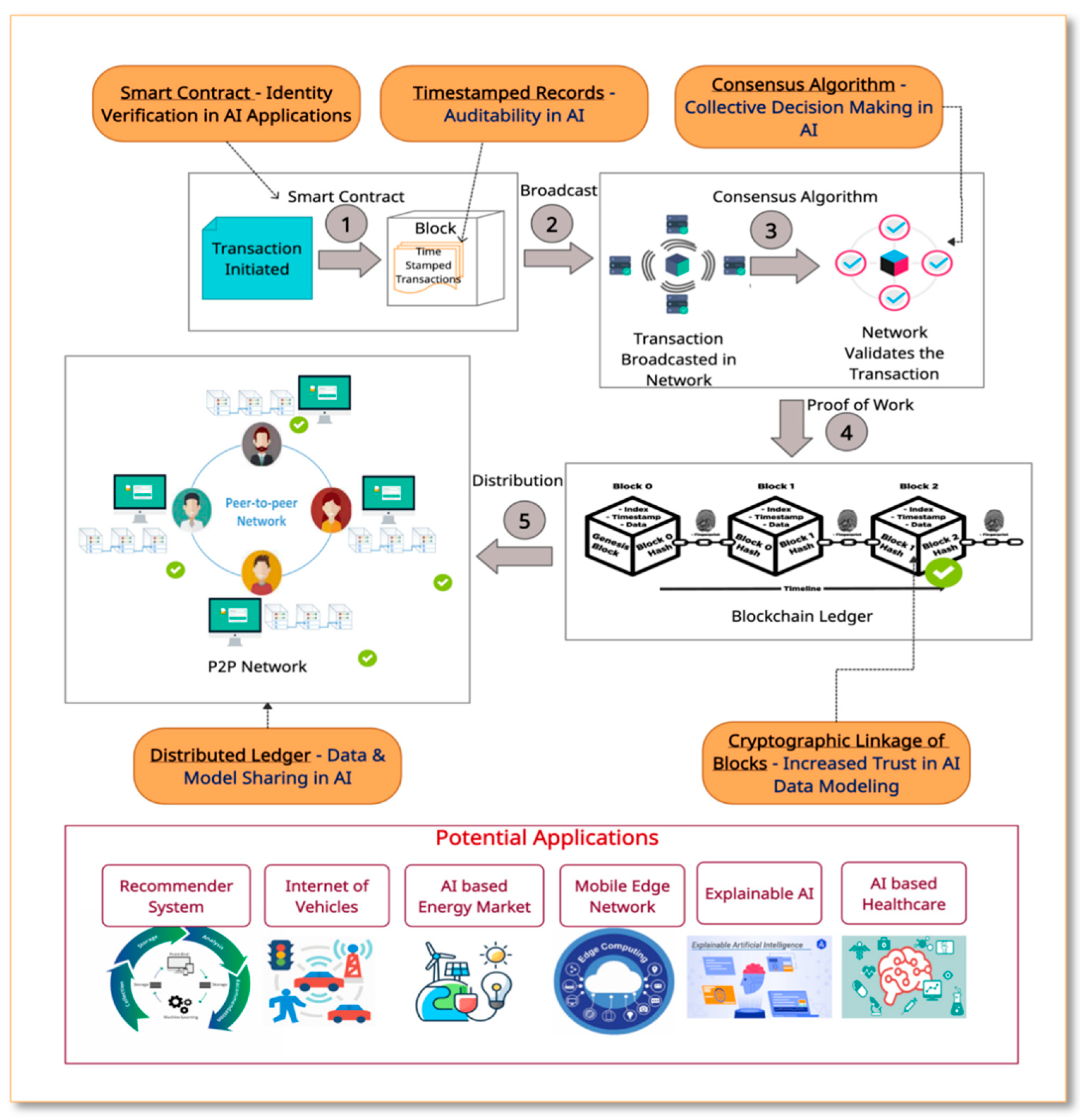
| Fundamental Keyword | “Blockchain” |
|---|---|
| Primary Keyword Using (AND) | “Artificial Intelligence” |
| Secondary Keywords Using (OR) | “Federated Learning,” “Deep Learning,” “Machine Learning,” “Privacy,” “Secure Sharing,” “Authentication,” “Cryptography,” “Privacy-Preserving,” “Access Control,” “Adversarial Attack,” “Adversarial Machine Learning” |
| Year | <2017 | 2017 | 2018 | 2019 | 2020 | 2021 | Total |
|---|---|---|---|---|---|---|---|
| SCOPUS Citations | 4 | 23 | 179 | 848 | 2613 | 1248 | 4915 |
| Web of Science Citations | 0 | 1 | 21 | 305 | 1413 | 593 | 2333 |
| Publication Year | Document Title | Authors | Source | 2017 | 2018 | 2019 | 2020 | 2021 | Total |
|---|---|---|---|---|---|---|---|---|---|
| Top 5 Documents from Scopus Database | |||||||||
| 2017 | Ouroboros: A provably secure proof-of-stake blockchain protocol | Kiayias A., Russell A., David B., Oliynykov R. | Lecture Notes in Computer Science | 2 | 48 | 130 | 153 | 36 | 369 |
| 2019 | Blockchain for AI: Review and open research challenges | Salah K., Rehman M.H.U., Nizamuddin N., Al-Fuqaha A. | IEEE Access | 0 | 0 | 47 | 89 | 40 | 176 |
| 2019 | 6G Wireless Networks: Vision, Requirements, Architecture, and Key Technologies | Zhang Z., Xiao Y. et al. | IEEE Vehicular Technology Magazine | 0 | 0 | 2 | 122 | 43 | 167 |
| 2019 | Building dynamic capabilities for digital transformation: An ongoing process of strategic renewal | Warner K.S.R., Wäger M. | Long Range Planning | 0 | 0 | 5 | 58 | 48 | 111 |
| 2018 | Converging blockchain and next-generation artificial intelligence technologies to decentralize and accelerate biomedical research and healthcare | Mamoshina, P., Ojomoko L. et al. | Oncotarget | 0 | 8 | 42 | 49 | 12 | 111 |
| Top 5 Documents from Web of Science Database | |||||||||
| 2019 | Blockchain for AI: Review and Open Research Challenges | Salah K., Rehman M.H.U., Nizamuddin N., Al-Fuqaha A. | IEEE ACCESS | 0 | 0 | 37 | 70 | 24 | 131 |
| 2019 | Building dynamic capabilities for digital transformation: An ongoing process of strategic renewal | Warner, Karl S. R., Waeger, Maximilian | LONG RANGE PLANNING | 0 | 0 | 3 | 43 | 31 | 77 |
| 2019 | On big data, artificial intelligence, and smart cities | Allam Z., Dhunny Z. | CITIES | 0 | 0 | 8 | 48 | 18 | 74 |
| 2019 | State of the Art of Machine Learning Models in Energy Systems, a Systematic Review | Mosavi., Salimi M., et al. | ENERGIES | 0 | 0 | 14 | 33 | 15 | 62 |
| 2020 | A Comprehensive Review of the COVID-19 Pandemic and the Role of IoT, Drones, AI, Blockchain, and 5G in Managing its Impact | Chamola V., Hassija V., Gupta V., et al. | IEEE ACCESS | 0 | 0 | 0 | 37 | 24 | 61 |
| Language | Scopus Database | Web of Science Database |
|---|---|---|
| English | 930 | 417 |
| Chinese | 17 | 0 |
| French | 2 | 0 |
| German | 2 | 2 |
| Russian | 2 | 10 |
| Turkish | 2 | 1 |
| Korean | 1 | 0 |
| Portuguese | 1 | 2 |
| Spanish | 1 | 7 |
| Ukrainian | 0 | 2 |
| Italian | 0 | 1 |
| Scopus (Document Type) | Publication Count |
|---|---|
| Conference Paper | 534 |
| Article | 312 |
| Review | 57 |
| Conference Review | 54 |
| Web of Science (Document Type) | Publication Count |
|---|---|
| Article | 283 |
| Proceedings Paper | 111 |
| Review | 48 |
| Country | Publication Count |
|---|---|
| China | 207 |
| United States | 147 |
| India | 102 |
| United Kingdom | 60 |
| Russian Federation | 45 |
| South Korea | 44 |
| Spain | 34 |
| Germany | 34 |
| Australia | 33 |
| Canada | 32 |
| Country | Publication Count |
|---|---|
| USA | 96 |
| China | 69 |
| England | 46 |
| India | 43 |
| Germany | 26 |
| South Korea | 26 |
| Russia | 25 |
| Australia | 24 |
| Canada | 19 |
| Spain | 17 |
| Links | TLS | Links | TLS | ||
|---|---|---|---|---|---|
| Blockchain | 159 | 643 | AI | 41 | 46 |
| Artificial Intelligence | 133 | 335 | Blockchain Technology | 42 | 45 |
| Internet of Things | 101 | 129 | Deep Learning | 46 | 43 |
| Machine Learning | 79 | 86 | Edge Computing | 47 | 41 |
| IoT | 80 | 85 | Industry 4.0 | 50 | 40 |
| Security | 69 | 85 | Internet of Things (Iot) | 57 | 38 |
| Big Data | 65 | 66 | Ethereum | 34 | 33 |
| Smart Contract | 49 | 66 | Cloud Computing | 54 | 31 |
| Smart Contracts | 48 | 50 | Digitalization | 18 | 29 |
| Privacy | 52 | 49 | Cybersecurity | 40 | 28 |
| Links | Citations | Pub. Year | Links | Citations | Pub. Year | ||
|---|---|---|---|---|---|---|---|
| Salah K. (2019) | 6 | 172 | 2019 | Zheng X. (2018) | 1 | 34 | 2018 |
| Zhang Z. (2019) | 1 | 165 | 2019 | Dimitrov D.V. (2019) | 1 | 30 | 2019 |
| Mamoshina P. (2018) | 3 | 111 | 2018 | Kumari A. (2020) | 1 | 24 | 2020 |
| Dinh T.N. (2018) | 4 | 53 | 2018 | Khan L.U. (2020) | 2 | 19 | 2020 |
| Singh S.K. (2020) | 1 | 42 | 2020 | Gammon K. (2018) | 1 | 13 | 2018 |
| Gupta R. (2020) | 3 | 40 | 2020 |
| Links | TLS | Documents | Citations | |
|---|---|---|---|---|
| IEEE Access | 9 | 16 | 26 | 483 |
| Future Internet | 4 | 7 | 4 | 19 |
| Transactions on Emerging Telecommunications Technologies | 4 | 7 | 4 | 8 |
| Journal of Parallel and Distributed Computing | 6 | 6 | 4 | 26 |
| Future Generation Computer Systems | 5 | 5 | 3 | 112 |
| ACM International Conference Proceeding Series | 2 | 4 | 30 | 57 |
| IEEE Transactions on Network Science and Engineering | 3 | 4 | 4 | 1 |
| Peer-To-Peer Networking and Applications | 3 | 4 | 3 | 0 |
| IEEE Internet of Things Journal | 3 | 3 | 6 | 4 |
| IEEE Communications Surveys and Tutorials | 2 | 2 | 3 | 78 |
| IEEE Network | 1 | 2 | 10 | 5 |
| Lecture Notes in Computer Science (Including Subseries Lecture Notes in Artificial Intelligence and Lecture Notes in Bioinformatics) | 2 | 2 | 87 | 580 |
| Proceedings—2020 IEEE International Conference on Blockchain, Blockchain 2020 | 2 | 2 | 5 | 1 |
| 2020 IEEE/ITU International Conference on Artificial Intelligence for Good, Ai4g 2020 | 1 | 1 | 3 | 0 |
| IEEE Transactions on Industrial Informatics | 1 | 1 | 4 | 61 |
| IFIP Advances in Information and Communication Technology | 1 | 1 | 3 | 1 |
| Lecture Notes of The Institute for Computer Sciences, Social-Informatics and Telecommunications Engineering, LNICST | 1 | 1 | 7 | 1 |
| Links | TLS | Documents | Citations | Links | TLS | Documents | Citations | ||
|---|---|---|---|---|---|---|---|---|---|
| Gupta R. | 7 | 31 | 6 | 67 | Huang J. | 3 | 3 | 3 | 3 |
| Tanwar S. | 7 | 31 | 6 | 67 | Kumar P. | 2 | 3 | 4 | 9 |
| Salah K. | 17 | 24 | 4 | 286 | Kumar R. | 2 | 3 | 3 | 8 |
| Kumar N. | 5 | 17 | 4 | 24 | Li W. | 3 | 3 | 7 | 1 |
| Wang F.-Y. | 7 | 14 | 6 | 147 | Liu W. | 3 | 3 | 6 | 2 |
| Al-Turjman F. | 6 | 11 | 3 | 40 | Wang X. | 3 | 3 | 13 | 84 |
| Yuan Y. | 7 | 11 | 4 | 125 | Yang C. | 3 | 3 | 3 | 5 |
| Wang Z. | 9 | 9 | 6 | 4 | Guo Y. | 2 | 2 | 3 | 88 |
| Park J.H. | 7 | 8 | 6 | 62 | Wang J. | 2 | 2 | 7 | 72 |
| Singh S.K. | 7 | 8 | 3 | 50 | Wang S. | 2 | 2 | 7 | 76 |
| Li J. | 7 | 7 | 11 | 71 | Yang X. | 1 | 2 | 4 | 0 |
| Zhang J. | 3 | 7 | 8 | 25 | Aloqaily M. | 1 | 1 | 3 | 44 |
| Fang J. | 6 | 6 | 3 | 1 | Kumar S. | 1 | 1 | 6 | 25 |
| Kochovski P. | 3 | 6 | 3 | 36 | Kumar V. | 1 | 1 | 3 | 26 |
| Lei K. | 6 | 6 | 3 | 1 | Qiu C. | 1 | 1 | 4 | 5 |
| Stankovski V. | 3 | 6 | 3 | 36 | Ridhawi I.A. | 1 | 1 | 3 | 44 |
| Wu J. | 5 | 5 | 3 | 53 | Wang W. | 1 | 1 | 5 | 11 |
| Yang W. | 5 | 5 | 3 | 52 | Wang Y. | 1 | 1 | 14 | 10 |
| Zhang Z. | 5 | 5 | 3 | 173 | Yu F.R. | 1 | 1 | 3 | 3 |
| Srivastava G. | 3 | 4 | 3 | 44 | Zhang K. | 1 | 1 | 5 | 1 |
| Wang L. | 3 | 4 | 5 | 13 | Zhang N. | 1 | 1 | 3 | 3 |
| Chen H. | 3 | 3 | 4 | 0 | Zhang X. | 1 | 1 | 5 | 6 |
| Links | TLS | Citations | Links | TLS | Citations | ||
|---|---|---|---|---|---|---|---|
| Lu Y. (2019a) | 48 | 45.3333 | 86 | De Keyser A. (2019) | 13 | 15 | 61 |
| Salah K. (2019) | 53 | 40.3333 | 172 | Lu Y. (2019b) | 17 | 15 | 57 |
| Gupta R. (2020) | 17 | 21 | 40 | Kumar A. (2020) | 14 | 15 | 8 |
| Singh S. (2020) | 20 | 20.5 | 24 | Wang S. (2018) | 19 | 14 | 63 |
| Yuan Y. (2017) | 12 | 18 | 49 | Moll J. (2019) | 21 | 14 | 29 |
| Singh S.K. (2020) | 23 | 18 | 42 | Acharjamayum I. (2019) | 48 | 14 | 5 |
| Tiberius V. (2019) | 19 | 18 | 13 | Qadri Y.A. (2020) | 13 | 12 | 49 |
| Ahad M.A. (2020) | 16 | 16 | 33 | Varga P. (2020) | 18 | 12 | 27 |
| Wang F.-Y. (2018) | 8 | 16 | 8 | Nguyen T. (2020) | 43 | 12 | 9 |
| Rahouti M. (2018) | 23 | 15.3333 | 24 | Azzaoui A.E. (2020) | 17 | 12 | 6 |
| Ref. | Framework | Integrity | Privacy | Public Availability of Ratings | Auditability | Incentives | Reputation |
|---|---|---|---|---|---|---|---|
| [31] | Decentralized Rating Framework | ✔ | ✖ | ✔ | ✔ | ✔ | ✔ |
| [32] | Decentralized Recommender System | ✔ | ✖ | ✔ | ✔ | ✔ | ✔ |
| [33] | Decentralized Knowledge Graph | ✔ | ✖ | ✖ | ✔ | ✔ | ✖ |
| [34] | Decentralized Privacy Preserved Recommender System | ✔ | ✔ | ✖ | ✔ | ✔ | ✔ |
| [35] | Recommendation system based on consortium blockchain | ✔ | ✖ | ✖ | ✔ | ✔ | ✔ |
| [36] | Blockchain based privacy protection strategy for Internet Financial product recommendation system. | ✔ | ✔ | ✖ | ✔ | ✖ | ✔ |
| [37] | Privacy Preserving Platform for Recommender Framework | ✔ | ✔ | ✖ | ✔ | ✔ | ✔ |
| Ref. | Framework | Objective | Secure | Fault Tolerant | Scalable | Privacy | Minimized Latency |
|---|---|---|---|---|---|---|---|
| [39] | blockchain-based federated learning pool (BFLP) framework | To address data silos and poor privacy preservation. | ✔ | ✔ | ✔ | ✔ | ✔ |
| [40] | Blockchain enabled IoV with multi-access edge computing | To enhance the performance of Video applications in IoV. | ✔ | ✔ | ✔ | ✔ | ✔ |
| [41] | Deep Learning and Blockchain scheme, DwaRa | To resolve the dynamic pricing and secure automated funds transfer. | ✔ | ✔ | ✔ | ✔ | ✔ |
| [42] | Blockchain-enabled vehicular crowdsensing system | To protect user privacy and data safety in 5G Internet of Vehicles (IoV). | ✔ | ✔ | ✔ | ✔ | ✔ |
| [43] | blockchain-enabled Internet of Vehicles (IoV) with Cooperative Positioning | To improve vehicular GPS positioning accuracy, system robustness, and security. | ✔ | ✔ | ✔ | ✔ | ✖ |
| [44] | a Deep Reinforcement Learning (DRL) and Blockchain empowered Spatial Crowdsourcing System (DB-SCS) | To address privacy of the task providers and receivers during the spatial crowdsourcing process. | ✔ | ✔ | ✔ | ✔ | ✔ |
| Ref. | Framework | Objective | Use Case |
|---|---|---|---|
| [22] | Blockchain-AI integration in Energy Trading System. | To address uncontrolled disclosure of information. | Energy Trading |
| [45] | Decentralized blockchain-enabled energy trading scheme | To address cross-domain energy trading and location privacy protection in centralized vehicular energy networks. | Energy Trading |
| [46] | Decentralized blockchain application and adaptive learning. | To address a diverse energy market transaction and a comprehensive energy usage. | Multi-Energy Market |
| Ref. | Framework | Objective | Fault Tolerant | Authenticity | Privacy | Anonymity | Integrity | Availability |
|---|---|---|---|---|---|---|---|---|
| [56] | B5G-enabled smart health care framework | To battle pandemics like COVID-19. | ✔ | ✖ | ✖ | ✖ | ✔ | ✔ |
| [57] | Chained Distributed Machine learning (C-DistriM) | To address paucity of transparency, which makes it difficult to trust the data utilized in the analysis. | ✔ | ✔ | ✖ | ✖ | ✔ | - |
| [58] | Blockchain and AI-empowered telesurgery system towards 6G (BATS) | To address challenges like security, throughput, reliability, trust, and transparency. | ✔ | ✔ | ✔ | ✖ | ✔ | ✔ |
| [59] | Deep Learning with Blockchain assisted secure image transmission and diagnosis model for the IoMT environment. | To address security, Privacy, and inadequate data. | ✔ | ✔ | ✔ | ✔ | ✔ | ✔ |
| [60] | deep-learning-based secure blockchain (ODLSB) enabled intelligent IoT and healthcare diagnosis model | To address centralized architecture, security, and privacy, resource constraints, and the lack of adequate training data. | ✔ | ✔ | ✔ | ✔ | ✔ | ✔ |
| Reference | Challenges in AI Addressed | Blockchain Solution | Blockchain Platform | Security Analysis | Application | Limitations |
|---|---|---|---|---|---|---|
| [29] | A centralized architecture provides the service. | Since there is no centralized authority, blockchain technology allows for decentralized ratings and ranking of various products. | Ethereum | Rating technique that is more straightforward and decentralized. | Recommender System | It does not affect collusion between the consumer and the owner of the products. Shilling attacks are a challenge. |
| [26] | Bias and adversarial attacks on AI implementations can poison the learning and inference processes. | The explanation is audited in a way that is immutable, tamper-proof, and distributed, as well as traceable and trackable with high reliability and resilience. | IPFS | XAI system that is more resilient, trustworthy, and capable of reducing discrimination and adversarial attacks. | Trustworthy AI Applications | Many more infrastructural prerequisites such as Security, Privacy, Dependability, Accessibility, Efficiency, and Governance are essential. |
| [21] | Lack of confidence among the participants and RSU, TA, and computational vehicle capacity, Data Poisoning Attack. | Blockchain-based batch authentication scheme for IoV. | Hyperledger Sawtooth. Voting-based Practical Byzantine Fault Tolerance (PBFT) consensus algorithm. | Data poisoning attacks are thwarted by preventing malicious transactions from being injected into the blocks and computing time effectiveness. | Blockchain-enabled batch authentication scheme in AI-envisioned IoV-based Smart City deployment | Not Mentioned |
| [22] | For learning and prediction, historical data should be trusted, explainable, and private. | The BC layer validates and handles the trading entities’ transactions. | PoA algorithm IOTA and “sharding.” | In a distributed network, it needed a trustworthy system to enable real-time security and transaction management. | Energy Market | Privacy and Data Access in Public Blockchain, Scalability and Accuracy, Security and Suitability, Lack of standards, interoperability, and regulations Cross-domain Research, Lack of Acceptance. |
| [13] | Model Poisoning Attack | Smart Contract in Blockchain executes Federated Learning process to protect against model poisoning. | Open-source Blockchain Platform | The falsified model updates are identified correctly, and model accuracy can satisfy in the presence of 30% of adversaries. | Federated Learning Application | Never tested for all the different parameters and not implemented in Open Source Blockchain Platform. |
| [23] | When using FL over mobile edge networks, there are security and trust problems to consider. | A two-layered architecture of blockchains: Local Model Update Chain (LMUC) assisted by Device-to-Device (D2D) communication and Global Model Update Chain (GMUC) supporting task sharding. | Hyper-ledger Fabric | It has been proven to effectively lower the time delay while maintaining a stable efficiency as the number of FL participants grows. | Mobile Edge Network | Local system mobility in the LMUC and complex network attack scenarios. |
| [25] | Since centralized systems lack security and traceability, the respective owner can temper the Explainable Artificial Intelligence (XAI) created explanations for his convenience to avoid any penalties. | Inter Planetary File System (IPFS) stores the explanations, and Smart Contract is designed for supervising the Ethereum Blockchain for storing and retrieving explanations. The Hash of explanations stored over Blockchain. | IPFS and Ethereum Blockchain | Integrity, authorization, transparency, availability, and non-repudiation are all primary security features of the proposed Blockchain-based solution. | XAI decisions Storage | Smart contract-based storage and retrieval functions take time and money to execute. |
| [27] | Privacy concerns in sharing healthcare records with third parties to make the AI model more Robust. Difficulty in building generalized prediction model for fragmented data. | Establishing access control rules through the smart contract for transacting personal healthcare records. | Blockchain—Smart contract | Helps in building robust AI models and sharing personal healthcare records without being compromised. | AI-Based Healthcare Application | The application is not yet developed and tested. |
| [73] | Distributed AI on IoT devices that are low-power and low-cost. | A Blockchain-based architecture supports DAI on low-power and low-cost IoT devices that are distributed, decentralized, and stable. | Public Blockchain platform, Honesty-based Distributed Proof of Authority via Scalable Work (HDPoA) | The implemented DAI has an accuracy of 92%-98%, with an energy cost of 0.12 joules (J) with Raspberry Pi to run one neuron. | Distributed Artificial Intelligence (DAI) using hardware platforms provided by the Internet of Things (IoT) | The effectiveness of using an Off-Chain solution, which could be suitable for applications that involve near-real-time response. |
| [28] | To establish a heterogeneous network for collecting a huge amount of data to combat COVID-19. | The encrypted transfer of patient data in the edge using blockchain technology. | Private Blockchain | The highest accuracy obtained by ResNet101was 97.1% | Pandemic (COVID-19) Screening and Diagnosis System. | To reduce the number of weights in the model by using mobile DL models. To use parallel processing in the edge computers. |
| Parameters | Cyber Attacks | Attacks on AI |
|---|---|---|
| Goal | Modify, obstruct, erase, handle, or steal data stored in computer systems by disabling, disrupting, destroying, or controlling them. | To make AI application malfunction that is wrong prediction or wrong classification. |
| Need of Computer | Yes | It may not be required. |
| Types of Attack | Brute Force Attack, Malware, Phishing, Denial of Service (DoS) | Input Attack, Poisoning Attack (Data/Algorithm/Model), Evasion Attacks |
| Causes | Bug, Human mistakes in code, Malicious Program | Adversarial Data, Intrinsic Model/Algorithm itself |
| Vulnerabilities in the system that cause an attack | Hidden Backdoor Programs. Unencrypted Data on the Network. Malware/Virus Checks are not performed on automated scripts. Security flaws that have yet to be discovered. | Machine Learning “learns” fragile patterns that function very well but can be easy to misunderstand. Dependency is mainly on data to corrupt a learning model. Auditing state-of-the-art algorithms are difficult due to their black box existence. |
| Need of Hacking | Yes | It may not be required. |
| Countermeasures | Cybersecurity Policies | Require Innovative Approaches and Solutions. |
| Author | Attacks | Type of Solution | Blockchain Platform | Application | Limitation |
|---|---|---|---|---|---|
| [77] | Sybil attack | Detection | Proof-of-Work Public Blockchain | Energy Trading | The reliability of the Blockchain system would be further assessed by calculating the number of transactions per second to increase the number of validators. |
| [78] | Sybil attack, Node replication attack, Wormhole attack, Sinkhole attack, Replay attack, Man-in-the-middle attack, Impersonation attack, Privileged-insider attack, Ephemeral Secret Leakage (ESL) attack | Detection & Mitigation | PBFT ECDSA signature verification Algorithm Public Blockchain | Internet of Everything | Not Mentioned |
| [79] | DDoS attack | Mitigation | Hyperledger Fabric | Multi-domain SDN network | A single client generates all transactions in the Blockchain network. |
| [80] | DDoS Attacks | Mitigation | Ethereum | IoT | Not Mentioned |
| [81] | Ransomware Attack | Defense | Hyperledger Fabric | Edge Computing | Determination of the size of the record is critical. |
| [82] | Byzantine Attacks | Defense | Secure Learning Chain Practical Byzantine Fault Tolerance (IPBFT) Consensus Algorithm | Distributed Machine Learning | Not Mentioned |
| [83] | Insider attacks (Betrayal attack, PMFA attack) | Intrusion Detection | Proof-of-Concept Blockchain | IoT | Scalability, Not tested for advanced insider attacks. |
| Security Triad | AI Security Requirement | Blockchain Solution | Blockchain Component | Description | Research Gap | Future Directions |
|---|---|---|---|---|---|---|
| Confidentiality | Access to Heterogeneous Data | Implications of Access Control Rules through Smart Contract | Smart Contract, Encrypted Block Data | Access to heterogeneous data can be controlled through smart contracts in Blockchain. Data owners can make data available to AI models/third parties while maintaining privacy and security. | Private Blockchain implies restrictions on access and exposure of the data, limiting AI to make correct decisions and analytics on limited data. | There should be some research in Private Blockchains for AI along with homomorphic encryption techniques. |
| Data Owner Identity | User Authentication through Blockchain | Digital Identities and Digital Signature of users/devices can be created and managed through Blockchain. It will protect the privacy of User/Device identity. | ||||
| Integrity | Trust on Data | Data Owner authentication along with traces of access. | Smart Contract, Mining, Cryptographic Linkage of Blocks, Encrypted Block Data, | The transaction of access to distributed data will be recorded in the Blockchain, which further helps to audit a transaction trail. | Public Blockchains are at high risk. In Public Blockchain, every transaction and user identity are publicly available in the network. The attacker may take advantage of this information to implement a 51% attack. | The computational environment at the Miner side is not protected and not under control. There should be a strategy to protect Hashing power of the miner. |
| Trust on Model | Storing Local Gradients from Federated Model in Blockchain | This will create a tamper-proof record of gradients, preventing Federated Learning Model from poisoning attack and establishing trust in the system. The accurate gradients without any alteration by the attacker are fed to the global learning model, ultimately promoting trusted prediction/classification. Consensus algorithm in the Blockchain helps the unreliable nodes in the network to achieve an agreement on data to make the network reliable. | ||||
| Execution of Learning Model through smart contracts | Execution of learning models can be controlled through smart contracts, as smart contracts are executable logic, which automatically gets triggered when any transaction in the network is initiated. This will prevent any attack on learning models and establish trust. | |||||
| Storing Explanations generated by XAI in Blockchain | Blockchain can maintain a tamper-proof, immutable trail of explanations generated by XAI in the distributed ledger. This will improve the functionality of XAI and brings transparency and trust to the AI system. | |||||
| Availability | Availability of Data/Model | Peer-to-Peer architecture and Distributed Ledger promotes high availability. | P2P Distributed Network, Distributed Ledger | With Peer-to-Peer Architecture of Network, highest level of availability is achieved. Failure of single node does not affect the network. Blockchain replica is available at every node in the network in the form of Distributed Ledger. | Consensus algorithms consume time to commit a block in the ledger after validating it. Integrating Blockchain with AI can introduce a delay in the system. | The research in developing light weight consensus algorithm should receive more exposure. |
| Integrating Blockchain with AI doubles the need of computational resources as both are complex technologies. | Future research directions can be optimizing resource utilization for AI and Blockchain. |
Publisher’s Note: MDPI stays neutral with regard to jurisdictional claims in published maps and institutional affiliations. |
© 2021 by the authors. Licensee MDPI, Basel, Switzerland. This article is an open access article distributed under the terms and conditions of the Creative Commons Attribution (CC BY) license (https://creativecommons.org/licenses/by/4.0/).
Share and Cite
Shinde, R.; Patil, S.; Kotecha, K.; Ruikar, K. Blockchain for Securing AI Applications and Open Innovations. J. Open Innov. Technol. Mark. Complex. 2021, 7, 189. https://doi.org/10.3390/joitmc7030189
Shinde R, Patil S, Kotecha K, Ruikar K. Blockchain for Securing AI Applications and Open Innovations. Journal of Open Innovation: Technology, Market, and Complexity. 2021; 7(3):189. https://doi.org/10.3390/joitmc7030189
Chicago/Turabian StyleShinde, Rucha, Shruti Patil, Ketan Kotecha, and Kirti Ruikar. 2021. "Blockchain for Securing AI Applications and Open Innovations" Journal of Open Innovation: Technology, Market, and Complexity 7, no. 3: 189. https://doi.org/10.3390/joitmc7030189
APA StyleShinde, R., Patil, S., Kotecha, K., & Ruikar, K. (2021). Blockchain for Securing AI Applications and Open Innovations. Journal of Open Innovation: Technology, Market, and Complexity, 7(3), 189. https://doi.org/10.3390/joitmc7030189







